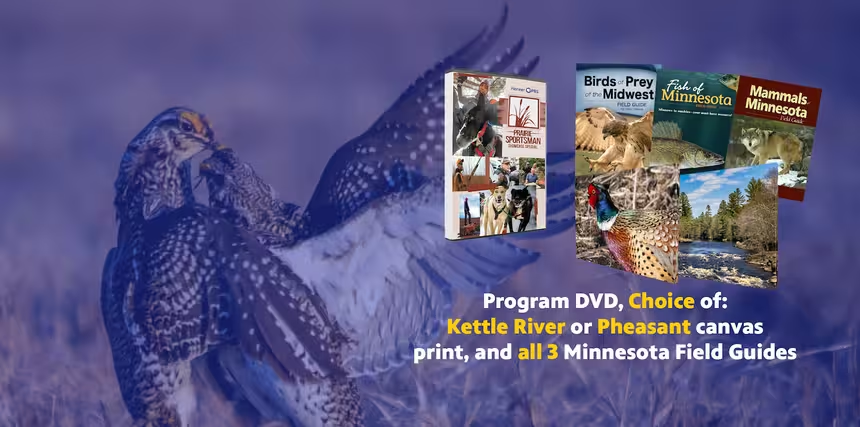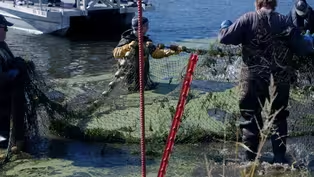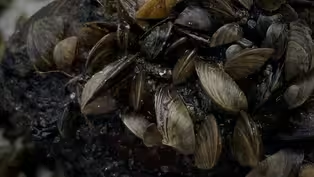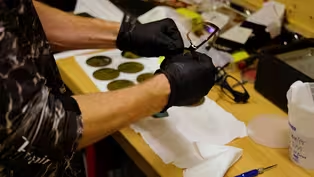Prairie Sportsman
Mobile Solar Panel
Clip: Season 16 Episode 11 | 5m 10sVideo has Closed Captions
Western Minnesota researchers develop mobile solar panels for cow pastures.
At the West Central Research and Outreach Center in Morris, researchers are exploring Agrivoltaics to reduce the financial risks for farmers. A relatively new idea, Agrivoltaics have both agriculture and solar utilizing the same land. WCROC has developed a solar shade power station that provides mobile shade to cattle while also collecting power.
Problems playing video? | Closed Captioning Feedback
Problems playing video? | Closed Captioning Feedback
Prairie Sportsman is a local public television program presented by Pioneer PBS
Production sponsorship is provided by funding from the Environment and Natural Resources Trust Fund, West Central Initiative, Shalom Hill Farm, and members of Pioneer PBS.
Prairie Sportsman
Mobile Solar Panel
Clip: Season 16 Episode 11 | 5m 10sVideo has Closed Captions
At the West Central Research and Outreach Center in Morris, researchers are exploring Agrivoltaics to reduce the financial risks for farmers. A relatively new idea, Agrivoltaics have both agriculture and solar utilizing the same land. WCROC has developed a solar shade power station that provides mobile shade to cattle while also collecting power.
Problems playing video? | Closed Captioning Feedback
How to Watch Prairie Sportsman
Prairie Sportsman is available to stream on pbs.org and the free PBS App, available on iPhone, Apple TV, Android TV, Android smartphones, Amazon Fire TV, Amazon Fire Tablet, Roku, Samsung Smart TV, and Vizio.

Prairie Sportsman Premium Gifts
Do you love the great outdoors, hunting, fishing, hiking and conservation? Consider becoming a friend of Prairie Sportsman to support it and receive gifts with your contribution.Providing Support for PBS.org
Learn Moreabout PBS online sponsorship(upbeat music) - [Bret] Farming has always been a risky endeavor.
Unpredictable weather, market fluctuations, pests, and disease can lead to serious trouble for farmers.
Any revenue source can be the difference between success and failure.
A relatively new idea called agrivoltaics, having both solar and agriculture use the same land, may provide some help.
At the West Central Research and Outreach Center in Morris, they are taking agrivoltaics on the road.
(upbeat music) - There are actually five areas of research happening at the Research and Outreach Center, most of them are agricultural.
There are 10 Research and Outreach Centers around the state of Minnesota, again, all doing agricultural and natural resources type research.
Our sort of guiding mission is to reduce fossil fuel use in agriculture.
We're one of the first and maybe still a sort of a rare example of agrivoltaics using grazing dairy cattle.
The solar array behind me is raised up off the ground about seven feet so that dairy cows can graze under it.
(upbeat music) - In previous studies, we've measured internal body temperature of cows.
So we've been able to reduce body temperature by over one degree Fahrenheit just by providing shade with solar.
- We had a masters student even do her thesis on studying if that shade provided by the solar panels would actually reduce heat stress in cows, and they found that, statistically, yes.
But, again, it's one of these examples where the grass is still growing, the forage is still growing under those solar panels because they're higher, and yet the cows get that benefit as well, and now we have another source of potential income for a farmer, you know, producing electricity on that same pasture that once was only grazing cows.
What we noticed is that you have a grazing dairy operation, so cows are moving to a different paddock every two to three days.
But the solar panels don't move, so we had this idea of like, what if the solar panels could move?
What if we could move the shade with the cows and the cows would always have the shade?
We would still collect electricity.
The problem being, of course, if you're moving the panels, how do you keep it connected to the electric grid?
So we designed a, what we're calling the SSPS, a Solar Shade Power Station, and we have batteries on that power station.
As the panels collect electricity, we store it in batteries, and then we can use it later.
- This is off-grid power, so you can, you know, use it to power, well, we have an electric tractor.
You can use it for maybe electricity for powering fences or irrigation.
I think the sky's the limit with our portable system.
- And depending on who you get the numbers from, in the United States, agriculture is about 10 to 11% of our total carbon footprint.
And if you look worldwide, it's about a quarter.
And agricultural loads are really difficult to decarbonize, so we've got big tractors, we've got animals, livestock buildings, which are unique, all this stuff is really difficult to decarbonize.
So I think that's what's exciting about the work we're doing here is it's necessary, we need to do this.
The challenge is really think about size.
So cows are big animals, and we wanna be able to provide enough shade for a good number of cows to make it worthwhile.
But yet, as you get a larger footprint of solar panels, the idea of moving them becomes more challenging.
How do we build a mobile trailer that can hold all these solar panels and fold up and then move?
This trailer now is almost 40 feet long and it's almost 40 feet wide when the panels are extended.
When the panels fold up, the trailer is a little bit less than 12 feet wide.
One other challenge with having a trailer that long is how are we gonna be able to steer through the gate?
So we actually purchased a used header trailer, which is designed to carry the combine head.
And this trailer we bought was only 17 feet long, but it had rear-wheel steering.
And we had a local shop basically chop it and extend it and make it 38 feet long.
And so we fired that up and we went out very slowly and we're checking things and watching parts to see if anything was moving or bending.
And, in the end, everything worked as designed, which is, you know, that's an engineer's dream.
I don't think I could overstate how excited we are to see it coming into fruition and to actually working as we designed it.
- Oh, definitely been a hit.
Yeah, they like going underneath it and spending the day underneath it out of the sunlight.
Less heat stress means more milk production, better fertility, and probably longer life.
- If it's successful and the shade part works and those cows, maybe they do produce more milk if they have access to shade all the time than the ones that don't, now suddenly you have an economic benefit from using it in addition to the electricity.
So that's offsetting your own electricity use, that's an income stream.
- The biggest thing is we're providing shade.
So why not utilize solar energy, produce energy and shade, and have happy cows.
(gentle upbeat music)
Camouflage Face Paints and Mobile Solar
Preview: S16 Ep11 | 30s | Host Bret Amundson visits RLVNT, learn about mobile solar panels, and aquatic invasive species. (30s)
Protecting Minnesota Waters from Invaders
Video has Closed Captions
Clip: S16 Ep11 | 6m 12s | Minnesota lottery dollars help stop the spread of aquatic invasive species. (6m 12s)
Video has Closed Captions
Clip: S16 Ep11 | 14m 16s | Bret visits RLVNT to learn about how they solve for real life vexes with new technology. (14m 16s)
Providing Support for PBS.org
Learn Moreabout PBS online sponsorship
- Science and Nature

Explore scientific discoveries on television's most acclaimed science documentary series.

- Science and Nature

Capturing the splendor of the natural world, from the African plains to the Antarctic ice.












Support for PBS provided by:
Prairie Sportsman is a local public television program presented by Pioneer PBS
Production sponsorship is provided by funding from the Environment and Natural Resources Trust Fund, West Central Initiative, Shalom Hill Farm, and members of Pioneer PBS.




